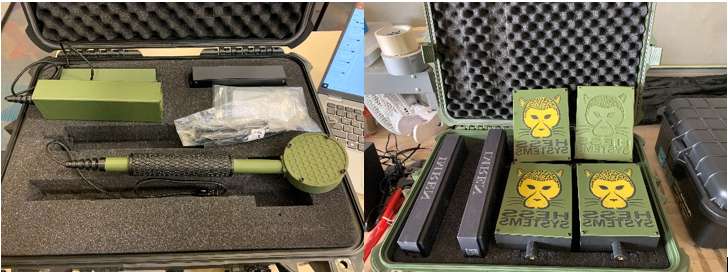
AR/VR CBRN Solution for Emergency Responders

Project #: 22-117 | Year 1 of 3
Brian Richardson,a Xavier Miller,a Mark Kilduffb
aNational Nuclear Security Administration/Counterterrorism Operations Support (NNSA/CTOS); bHess Systems
Executive Summary
This project creates additional capabilities to enhance the function and accuracy of the Virtual Radiation Training through Ubiety System (VIRTUS) by creating external probes and a location beacon array to allow First Responders and military personnel to more accurately and completely simulate chemical, biological, radiological, nuclear, and high explosive (CBRNE) detection in virtual and augmented reality training programs.
Description
Realistic training is costly but necessary. In order to reduce the cost of and improve access to realistic training to the first responder and military communities, augmenting live-agent training with a simulation training system is a viable solution. There are several realistic CBRNE simulation systems on the market, but they are very costly. This challenge was partially overcome by the introduction of the Defense Threat Reduction Agency (DTRA) developed VIRTUS which uses Android® based devices to emulate radiation and chemical detection systems providing reduced cost realistic training capabilities.
There are two major drawbacks to the VIRTUS system. First, because it is based on Android® devices, location accuracy requires improvement. Second, there is no external probe capability or the ability to realistically simulate alpha and beta radiation detection and low volatility chemical contamination.
This project has created three prototype smart probes to interface with the VIRTUS devices. Using a variety of technologies such as radio ranging, infra-red ranging, and accelerometers, these probes provide an external probe capability along with improved location accuracy and distance to surface measurements.
During initial testing, these probes proved to greatly improve the location accuracy from greater than 15 ft to less than 1 ft. Utilizing additional capabilities like Bluetooth Low Energy (BLE) beacons and radio frequency identification devices (RFIDs), they also accurately simulate alpha and beta surface contamination.

Conclusion
During the first year of this project, we developed the three prototype external simulation probes (α, β, γ) and radio frequency (RF) ranging/location pucks that have been tested to improve the accuracy of the VIRTUS location to less than 1 ft. We have also created the capability to accurately simulate alpha and beta radioactive contamination detection. The goal for the second year of this project is to continue to improve the location accuracy, format, and functionality of the probes. We will also develop software algorithms in order to ingest the output location, distance, and identification information into the VIRTUS system.
Mission Benefit
The current VIRTUS system relies on two main technologies for location accuracy in a simulated contaminated environment and simulated radioactive sources. First, GPS location information available to Android® based smart phones has an accuracy of approximately ±15 ft. These probes and RF ranging pucks greatly improve the effectiveness of VIRTUS as a training tool as well as create additional capabilities. Second, BLE devices have a slow data transmission rate, creating inaccurate and sometimes non-repeatable indications. This issue requires multiple devices to be placed together that only improves the location accuracy to an unacceptable 3 ft. The addition of the probes improves the location accuracy to approximately 3 in. with the added ability to simulate the under 1-in. requirement to detect alpha radiation.
The VIRTUS tool is currently either listed, or pending listing, as an NNSS asset on a DOE-wide platform. VIRTUS is currently the premier virtual tool in use by National Guard Bureau’s Homeland Response Force (HRF) CBRNE Enhanced Response Force Package (CERFP) branch.
Both the NGB Civil Support Team (CST) branch, and US Army NORTHCOM have re-engaged in this effort, with CST funding VIRTUS training beginning within the next year (FY 2023–2027 funding period). Work done on our end will likely be adopted within the framework of a Technical Transfer Agreement that NNSA-CTOS, DTRA Research and Development, and JPEO-CBRND are signatories on.
This work was done by Mission Support and Test Services, LLC, under Contract No. DE-NA0003624 with the U.S. Department of Energy. DOE/NV/03624–1627.
Return to Enabling Technologies for Autonomous Systems and Sensing
Go to SDRD Annual Report Index
Return to SDRD Homepage
